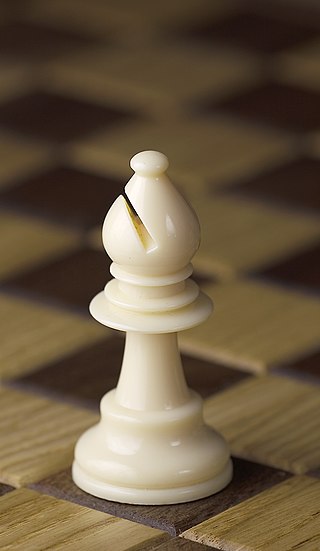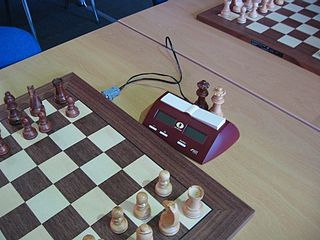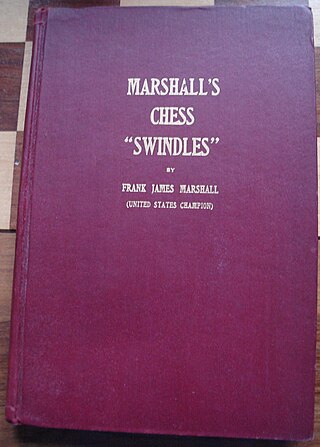
The bishop is a piece in the game of chess. It moves and captures along diagonals without jumping over intervening pieces. Each player begins the game with two bishops. The starting squares are c1 and f1 for White's bishops, and c8 and f8 for Black's bishops.
The endgame is the final stage of a chess game which occurs after the middlegame. It begins when few pieces are left on the board.
In the game of chess, perpetual check is a situation in which one player can force a draw by an unending series of checks. This typically arises when the player who is checking cannot deliver checkmate, and failing to continue the series of checks gives the opponent at least a chance to win. A draw by perpetual check is no longer one of the rules of chess; however, such a situation will eventually allow a draw claim by either threefold repetition or the fifty-move rule. Players usually agree to a draw long before that, however.
The fifty-move rule in chess states that a player can claim a draw if no capture has been made and no pawn has been moved in the last fifty moves. The purpose of this rule is to prevent a player with no chance of winning from obstinately continuing to play indefinitely or seeking to win by tiring the opponent.
The Lucena position is one of the most famous and important positions in chess endgame theory, where one side has a rook and a pawn and the defender has a rook. Karsten Müller said that it may be the most important position in endgame theory. It is fundamental in the rook and pawn versus rook endgame. If the side with the pawn can reach this type of position, they can forcibly win the game. Most rook and pawn versus rook endgames reach either the Lucena position or the Philidor position if played accurately. The side with the pawn will try to reach the Lucena position to win; the other side will try to reach the Philidor position to draw.

Checkmate is any game position in chess and other chess-like games in which a player's king is in check and there is no possible escape. Checkmating the opponent wins the game.
The two knights endgame is a chess endgame with a king and two knights versus a king. In contrast to a king and two bishops, or a bishop and a knight, a king and two knights cannot force checkmate against a lone king. Although there are checkmate positions, a king and two knights cannot force them against proper, relatively easy defense.
The Saavedra position is one of the best-known chess endgame studies. It is named after the Spanish priest Fernando Saavedra (1849–1922), who lived in Glasgow during the late 19th century. Though not a strong player, he spotted a win involving a dramatic underpromotion in a position previously thought to have been a draw.

In chess, promotion is the replacement of a pawn with a new piece when the pawn is moved to its last rank. The player replaces the pawn immediately with a queen, rook, bishop, or knight of the same color. The new piece does not have to be a previously captured piece. Promotion is mandatory when moving to the last rank; the pawn cannot remain as a pawn.

The Tarrasch rule is a general principle that applies in the majority of chess middlegames and endgames. Siegbert Tarrasch (1862–1934) stated the "rule" that rooks should be placed behind passed pawns – either the player's or the opponent's. The idea behind the guideline is that (1) if a player's rook is behind his passed pawn, the rook protects it as it advances, and (2) if it is behind an opponent's passed pawn, the pawn cannot advance unless it is protected along its way.
The chess endgame with a king and a pawn versus a king is one of the most important and fundamental endgames, other than the basic checkmates. It is an important endgame for chess players to master, since most other endgames have the potential of reducing to this type of endgame via exchanges of pieces. Players need to be able to determine quickly whether a given position is a win or a draw, and to know the technique for playing it. The crux of this endgame is whether or not the pawn can be promoted, so checkmate can be forced.
In chess, the exchange is the material difference of a rook for a minor piece. Having a rook for a minor piece is generally advantageous, since the rook is usually more valuable. A player who has a rook for a minor piece is said to be up the exchange, and the other player is down the exchange. A player who wins a rook for a minor piece is said to have won the exchange, while the other player has lost the exchange. The opposing captures often happen on consecutive moves, but this is not strictly necessary. Although it is generally detrimental to lose the exchange, one may occasionally find reason to purposely do so; the result is an exchange sacrifice.
In chess, a fortress is an endgame drawing technique in which the side behind in material sets up a zone of protection that the opponent cannot penetrate. This might involve keeping the enemy king out of one's position, or a zone the enemy cannot force one out of. An elementary fortress is a theoretically drawn position with reduced material in which a passive defense will maintain the draw.
The rook and pawn versus rook endgame is a fundamentally important, widely studied chess endgame. Precise play is usually required in these positions. With optimal play, some complicated wins require sixty moves to either checkmate, capture the defending rook, or successfully promote the pawn. In some cases, thirty-five moves are required to advance the pawn once.
In chess, a blunder is a critically bad move or decision. A blunder severely worsens the player's situation by allowing a loss of material, checkmate, or anything similar. It is usually caused by some tactical oversight, whether due to time trouble, overconfidence, or carelessness. Although blunders are most common in beginner games, all human players make them, even at the world championship level. Creating opportunities for the opponent to blunder is an important skill in over-the-board chess.
The chess endgame of a queen versus pawn is usually an easy win for the side with the queen. However, if the pawn has advanced to its seventh rank it has possibilities of reaching a draw, and there are some drawn positions with the pawn on the sixth rank. This endgame arises most often from a race of pawns to promote.

In chess, a swindle is a ruse by which a player in a losing position tricks their opponent and thereby achieves a win or draw instead of the expected loss. It may also refer more generally to obtaining a win or draw from a clearly losing position. I. A. Horowitz and Fred Reinfeld distinguish among "traps", "pitfalls", and "swindles". In their terminology, a "trap" refers to a situation where players go wrong through their own efforts. In a "pitfall", the beneficiary of the pitfall plays an active role, creating a situation where a plausible move by the opponent will turn out badly. A "swindle" is a pitfall adopted by a player who has a clearly lost game. Horowitz and Reinfeld observe that swindles, "though ignored in virtually all chess books", "play an enormously important role in over-the-board chess, and decide the fate of countless games".
The opposite-colored bishops endgame is a chess endgame in which each side has a single bishop and the bishops reside on opposite-colored squares. Without other pieces besides pawns, these endings are widely known for their tendency to result in a draw. These are the most difficult endings in which to convert a small material advantage to a win. With additional pieces, the stronger side has more chances to win, but not as many as when bishops are on the same color.
A pawnless chess endgame is a chess endgame in which only a few pieces remain, and no pawns. The basic checkmates are types of pawnless endgames. Endgames without pawns do not occur very often in practice except for the basic checkmates of king and queen versus king, king and rook versus king, and queen versus rook. Other cases that occur occasionally are (1) a rook and minor piece versus a rook and (2) a rook versus a minor piece, especially if the minor piece is a bishop.
The rook and bishop versus rook endgame is a chess endgame where one player has just a king, a rook, and a bishop, and the other player has just a king and a rook. This combination of material is one of the most common pawnless chess endgames. It is generally a theoretical draw, but the rook and bishop have good winning chances in practice because the defense is difficult. Ulf Andersson won the position twice within a year, once against a grandmaster and once against a candidate master; and grandmaster Keith Arkell has won it 27 times out of 27. In positions that have a forced win, up to 59 moves are required. Tony Kosten has seen the endgame many times in master games, with the stronger side almost always winning. Pal Benko called this the "headache ending." David Howell observed, "Especially below elite grandmaster level, this is one of the hardest endgames to draw."






